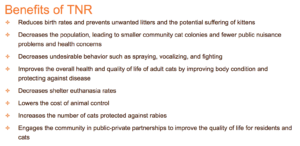NBC channel 8 in Hillsborough, Florida, made an investigative report last August called “Rabies immunization procedure different for pets and feral cats in Hillsborough”. They were looking into why there are different protocols for Rabies vaccination for feral and owned cats. A local veterinarian questioned why owned cats must be boostered while feral cats in TNR programs are legally exempt. The report speaks about how they are the same species yet feral cats are treated as ‘one shot and done’ for Rabies immunization. In this article, we look to evaluate if there should be a difference and why.

A left ear tip means the cat has been sterilized.
First let’s talk about TNR. TNR stands for Trap-Neuter-Release (or Return) and is a humane method of controlling stray and feral cat overpopulation. Cats are sterilized, vaccinated against Rabies, and a small piece of the tip of the left ear is removed to identify the cat as sterilized. This allows trappers to know that a particular cat has already been taken care of, so they do not re-trap and waste money and resources on an already sterilized cat. TNR is for any outdoor cat, so stray, feral and wild cats (and the occasional indoor/outdoor cat) are often presented to high volume sterilization clinics for the procedure.
But why participate in TNR? Operation Catnip describes the following benefits of TNR programs:

In short, the idea of TNR is that it humanely reduces the population of community cats by decreasing litters. It eliminates future generations, so when the cats die from natural diseases or other causes there are no more generations to keep the population going. This process also reduces the intake of cats into shelters, since outdoor cats are seen as living outside instead of being homeless and thus kept out of the shelter system.
As listed by Operation Catnip, one of the goals is to increase the number of cats protected against Rabies. Cats are given a single vaccine prior to release. Given that most of these cats are not owned, there is no way to know when they should be trapped again for Rabies booster. What does it mean for a cat’s immune system to only be vaccinated once? Why are the requirements to give a first Rabies vaccine between 12-16 weeks of age and then a booster a year later, which is then good for three years? It is time to learn some immunology (based on Duration of Immunity of Canine and Feline Vaccines by Ronald D. Shultz).
When a vaccine is injected, the body develops antibodies against the particles in the vaccine. The immune system is pretty smart and has a good memory, so when a vaccine is given once, it may start to forget over time (decreased immunity) but when it sees it again (booster) it recognizes it and is able to respond much stronger and for a longer period of time. The scientific name for how long a vaccine lasts is DOI, or Duration of Immunity. Vaccine guidelines are based on these DOI numbers. After booster, the DOI of Rabies vaccine is greater or equal than 3 years, which is the basis for the 3 year booster recommendation. Therefore, a feral cat receiving a one-time Rabies vaccine will have a DOI greater or equal than 1 year, which is not perfect but still help decrease the population of cats susceptible to Rabies.
Should feral cats be vaccinated more than once? In a perfect world yes. But these are cats with no owners. In my opinion, a feral cat is wildlife. You should not bring a feral cat into your home same as you shouldn’t bring in a squirrel or a raccoon (notice I say ‘shouldn’t as I know some people that have been silly enough to do this). Similar to wildlife, you try to vaccinate when you can, but you do not hold any one person accountable for their vaccination as they are not owned animals. This also means that an ear tipped cat denotes that it has been vaccinated at least once, but in the event of a bite it should be treated the same as an unvaccinated cat.
Back to the story. The NBC 8 report mentioned that, based on interpretation of Hillsborough law, a person can ear tip their cat and that makes it be considered ‘feral’, so they can only have one Rabies vaccine for life. Seriously now? I suppose we should discuss the definition of a feral cat to help clear this up. Alley Cats Allies defines a feral cat as:

By this definition, you can tip your pet’s ear, but it is still your pet and you have to follow the legal requirements for their care based on your city and state regulations.
Back to the original argument: should feral cats be held to different standards? No, but that is not really the point. We are not talking about an immune issue, we are talking about a legal one. The immune system will work the same regardless of how social or not a cat is. The law is made to hold owners accountable for their pet’s Rabies vaccination being current. The purpose of TNR is to help control cat overpopulation humanely. We need to keep in mind that there is a difference between a person doing TNR and a caretaker or an owner. The first is trying to perform a public service. The other two have made a conscious decision to make an effort to care for an animal, and thus should do their best to protect them and the community against preventable diseases. My recommendation, and what we do at our practice, is that if a cat presented for TNR is already fixed, we give them another Rabies vaccine. That way we increase the chances it will have good immunity against Rabies.
If you would like to submit a topic or specific question you would like for Dr. G to address in this blog, let us know by sending an email with Rascal’s Corner in the subject line.
Email to askDrG@generationwags.com
To view all posts in Rascal’s Corner click here!

